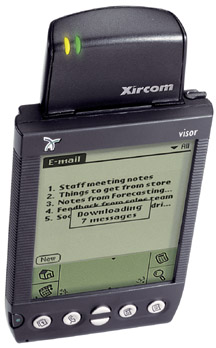Never before has been reviewing a product so satisfying and fuss-free. I already had the 802.11b network access points set up in our office as well as home, due to my recent experiments with my Apple iBook's AirPort card and my PC notebook with a Symbol WiFi card, so it was a trivial matter to install the Palm m500 sled and follow the simple instructions in the manual. In just five minutes I was up and running, browsing with Blazer and syncing with AvantGo as I wandered around the office. It only took a few more minutes, and a little more concentration, to set it up for wireless HotSync, but it was worth it as I sat on the sofa, pressed the onscreen HotSync button and heard the happy connection chimes resound so far from any cumbersome wired connection.
The most interesting surprise on connecting the sled to the m500 was that the software loaded automatically from the sled through the Universal connector, something I wasn't sure it could do. Palm now has the functionality that Springboard has. There are no CDs included with the product, something I didn't expect. Also not included with the product was an AC power supply. At first I thought this was a mistake, but I found out later that it's designed to be used with the Palm's existing AC adapter. Just unplug it from your cradle connector and plug it into the Xircom LAN Module, and you charge both the module and the Palm at the same time. Once you set up HotSync, you can actually put the cradle back in its box, because you'll no longer need it. The Xircom sled becomes both cradle and charger and wireless modem, as long as you're in range of an access point.

As you can see in the photo above left, the Palm version is not terribly slim, though it appears so from the front view. I don't count this as a major strike against it, however. It fits very comfortably in the hand and is quite lightweight, lighter than the m500 itself. Of all the attachment mechanisms I've seen for the m500 series, this one feels the most secure, and its release mechanism is sure, with little snagging.
On the back are two rubber feet to prevent it sliding across the desktop. Activity indicators on the front show battery charge status on the left (orange for charging, green for charged), and a green light on the right shows connection status and activity.
Perhaps the best news is that the sled is smart enough to shut off when the Palm is shut off, yet it fires right back up in four to six seconds and is ready to go. With light use, the 3.7V Li-ion battery will last a few days between charges, or about six hours of continuous use in my tests.

As I mentioned, I use it both at work and at home, which of course necessitates setting it up for two different networks. With many PCs this can be an incredible hassle; less so with a Mac. But nothing's as easy as this. Just open the XircomPWE application, select "Client Settings" and tap on the number of your desired profile. Under each profile, you can save settings for the different networks, including encryption, IP address, Network Type, and even Power management. The only thing I wasn't able to do was to HotSync to a PC at the office and a PC at home. A software update might help here, but it looks like Palm's Network HotSync is limited to the one computer. In the meantime, rather than put the cradle away, just take it home and HotSync that way.
The Xircom LAN module is an excellent example of what future Palm OS expansion options ought to be: simple, light, quick, and trouble-free. At US$299, it's a little steep for most consumers, but just right for the businesses likely to find it useful.
www.xircom.com
-Shawn Barnett
Back to Palm Section

